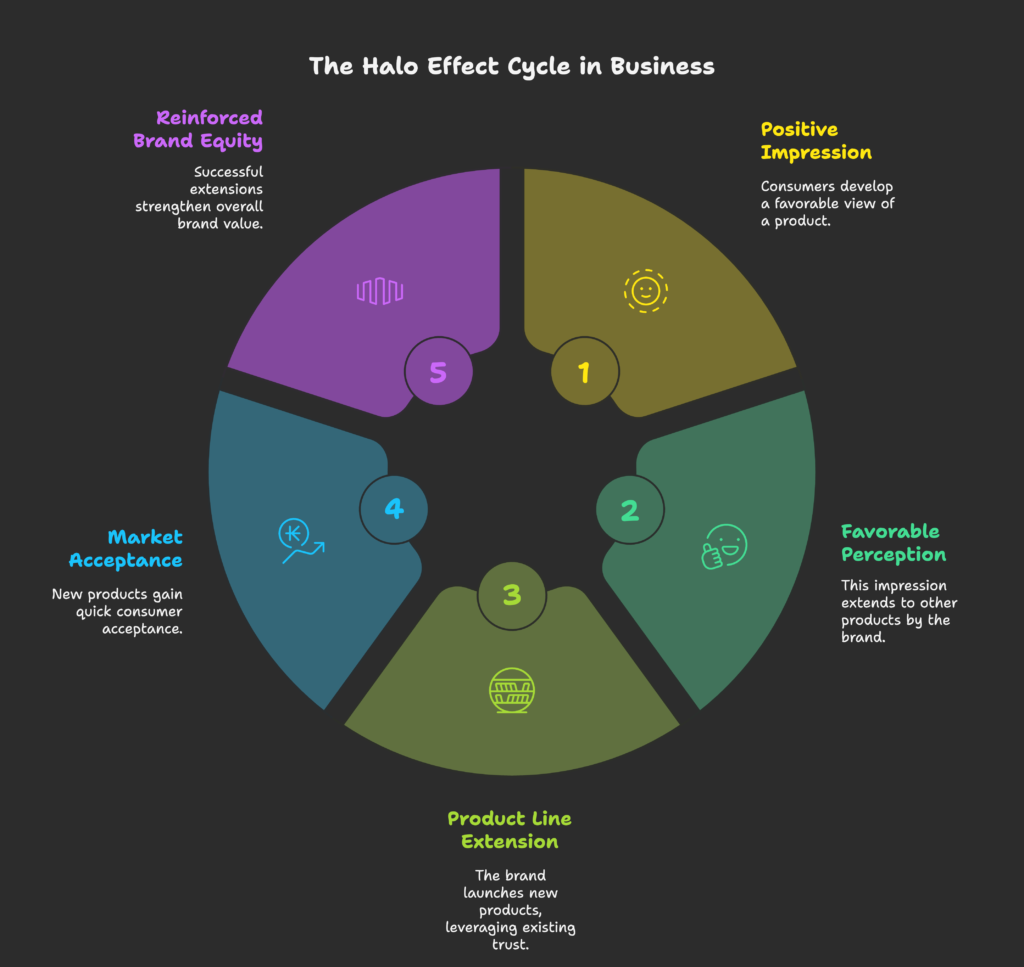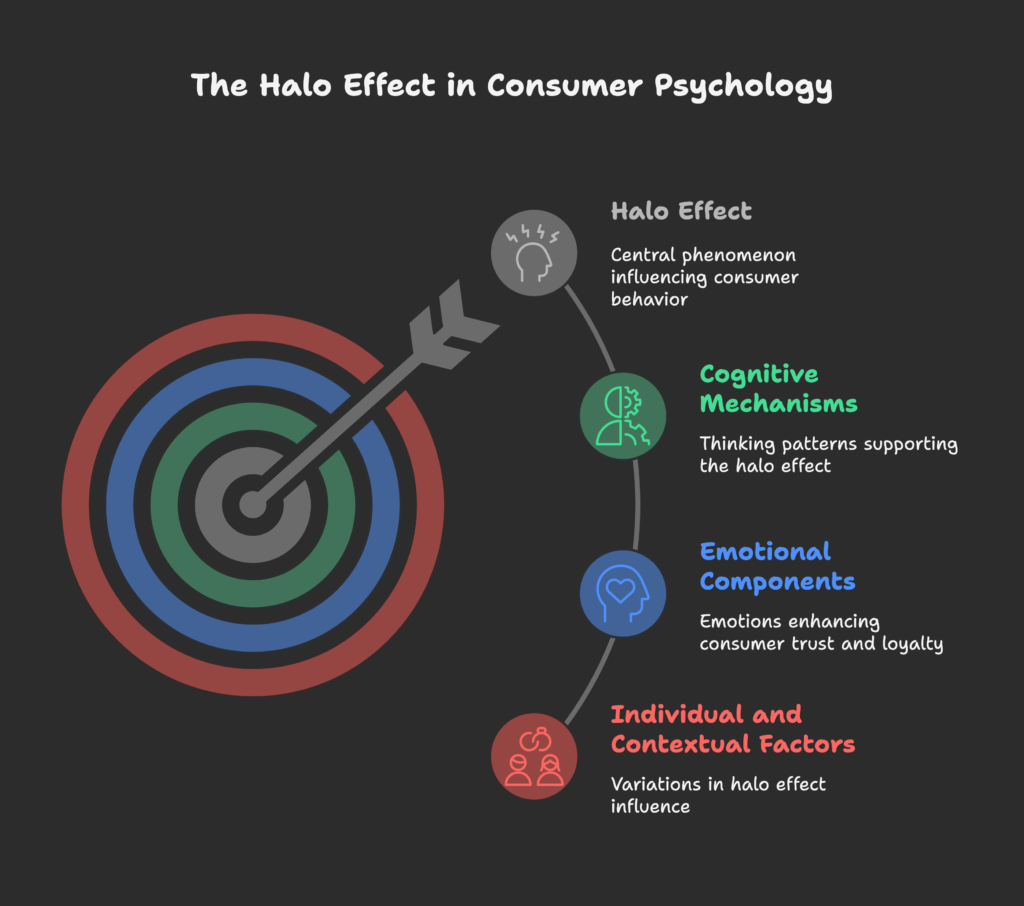Have you ever bought a new product simply because you loved another product from the same brand? Or maybe you’ve trusted a company’s new offering without much research because their other products never disappointed you? If so, you’ve experienced the halo effect in action!
The halo effect is a powerful psychological phenomenon that smart businesses leverage every day. It’s like a secret superpower that helps established brands launch new products with less risk and higher chances of success.
In this article, you’ll discover:
- What the halo effect is and why it matters for product extensions
- The psychology behind why consumers transfer positive feelings from one product to another
- Different types of product extensions that leverage the halo effect
- Real-world examples of companies that have mastered this strategy
- Practical steps to implement this approach in your own business
So whether you’re a business owner planning your next product launch, a marketer working on brand strategy, or simply curious about the psychology that influences your purchasing decisions, this article will give you valuable insights. Let’s dive in!
Understanding the Halo Effect in Product Line Extensions
Before we explore how to leverage the halo effect for your business, let’s make sure we’re on the same page about what it actually means.

What Is the Halo Effect?
The halo effect is a cognitive bias where our positive impression of something in one area influences our opinion in another area. In the context of products and brands, it means that if consumers like one product from your brand, they’re more likely to view your other products favorably too—even without trying them!
This concept has been studied since psychologist Edward Thorndike first identified it in the early 1900s, but its application in modern business strategy has become increasingly sophisticated and deliberate.
Why the Halo Effect Matters for Business
For businesses, the halo effect offers several significant advantages:
- Lower costs and risks when launching new products
- Faster market acceptance compared to starting from scratch with a new brand
- Competitive advantage through positive associations consumers already have
- Reinforced brand equity when the extensions succeed
Consider the difference between launching a completely new product with an unknown brand versus launching under an established brand that consumers already trust. The second option typically requires less marketing investment and faces fewer barriers to trial.
How Consumers Make Decisions
When faced with countless product choices, consumers use mental shortcuts to make decisions. The halo effect is one such shortcut. Instead of researching every aspect of a new product, consumers often think: “I liked their other products, so I’ll probably like this one too.”
This trust transfer mechanism is powerful—it saves consumers mental energy while giving brands a valuable advantage when expanding their product lines.
Now that we understand what the halo effect is, let’s explore the fascinating psychology behind it. What exactly happens in consumers’ minds that makes this effect so powerful?
The Psychology Behind the Halo Effect
What makes our brains transfer positive feelings from one product to another? Let’s look at the psychological mechanisms at work.

Cognitive Mechanisms
Several thinking patterns contribute to the halo effect:
- Confirmation bias: Once we like a brand, we tend to notice information that confirms our positive view while overlooking negative aspects.
- Cognitive consistency: Our brains prefer consistent beliefs, so if we think “Brand X makes good products,” we’ll naturally extend that belief to new offerings.
- Central nucleus theory: Core brand associations (like quality or innovation) transfer more readily than peripheral ones.
These mechanisms help explain why we often give new products from trusted brands the benefit of the doubt before we’ve even tried them.
Emotional Components
The halo effect isn’t just logical—it’s deeply emotional:
- Trust is perhaps the most valuable transferable emotion. When consumers trust your brand, they’ll be more willing to try your new products.
- Loyalty acts as a powerful extension facilitator. Loyal customers are often your first adopters for new products.
- Risk reduction through familiarity makes consumers feel safer trying your new offerings.
These emotional connections often predict extension success better than rational factors.
Individual and Contextual Factors
Not everyone is equally influenced by the halo effect. Key factors include:
- Consumer expertise: Experts in a category may be less influenced by halos and more critical of extensions.
- Demographics: Different age groups and cultural backgrounds show varying degrees of halo susceptibility.
- Situational context: The purchasing environment and occasion can strengthen or weaken halo effects.
Understanding these variations helps businesses target the right audiences with their extensions.
Now that we understand the psychological forces at work, let’s look at the different ways businesses can extend their product lines to take advantage of the halo effect. Each approach offers unique benefits and challenges!
Types of Product Line Extensions
Not all product extensions work the same way. Let’s explore the main categories and how they leverage the halo effect differently.
Vertical Extensions: Moving Up or Down Market
Vertical extensions involve moving up or down in price and quality within the same product category:
- Upward extensions: Creating premium versions of your products (like when Toyota created Lexus)
- Downward extensions: Offering more affordable options (like Mercedes-Benz’s A-Class)
The challenge with vertical extensions is maintaining consistent quality perceptions. When moving upmarket, you need to convince consumers your brand deserves premium status. When moving downmarket, you must ensure cheaper products don’t damage your brand’s quality reputation.
Horizontal Extensions: New Features or Variations
Horizontal extensions stay within the same price/quality range but offer new features or variations:
- New flavors or styles (like Coca-Cola’s many flavor variations)
- Feature additions (like when a shampoo brand adds conditioner)
- Format changes (like when a food product offers single-serve packaging)
These extensions are typically lower risk because they stay close to the parent brand’s core competencies while offering consumers more choices.
Technological Extensions
These extensions apply a brand’s technological expertise to new applications:
- New functionalities based on existing technology
- Digital extensions of physical products
- Cross-category applications of technological expertise
Apple provides a classic example with its ecosystem extending from computers to iPods, iPhones, iPads, watches, and services—all leveraging the brand’s reputation for user-friendly technology and design.
Each type of extension transfers the halo effect differently. But how exactly does this transfer work? Let’s explore the mechanisms that make the magic happen!
How the Halo Effect Transfers to New Products
The transfer of positive associations isn’t automatic. Let’s examine the mechanisms that determine whether the halo effect will successfully extend to new products.
Central vs. Peripheral Brand Associations
Not all brand associations transfer equally:
- Core associations (like quality, reliability, or innovation) transfer more readily across products.
- Peripheral associations (like specific features or aesthetics) may only transfer to closely related products.
Research shows that successful extensions strategically emphasize the transferable core associations while adapting peripheral elements to fit the new category.
Congruency Factors
Several factors affect how well positive associations transfer:
- Brand-self congruency: How well the brand aligns with consumers’ self-image
- Category fit: How logically connected the new category is to the original
- Perceived risk: Higher risk extensions face more scrutiny
The stronger the congruency, the more likely the halo effect will successfully transfer.
Communication Strategies
How you frame the extension significantly impacts transfer success:
- Functional vs. symbolic framing: Highlighting practical benefits or emotional connections
- Consistency messaging: Maintaining alignment with the parent brand’s positioning
- Believability: Ensuring extensions feel authentic to the brand
The most effective communication strategies emphasize the brand associations most relevant to the new category while maintaining overall brand consistency.
Understanding these transfer mechanisms is important, but nothing beats seeing real-world examples. Let’s look at some successful case studies that show the halo effect in action!
Real-World Examples of Successful Halo-Driven Extensions
Theory is helpful, but seeing successful halo effect applications in the real world can be even more illuminating. Let’s explore some standout examples across different industries.
Technology Sector
The tech industry offers some of the most visible examples of successful halo-driven extensions:
- Apple: Perhaps the ultimate example of the halo effect, Apple extended from computers to music players (iPod), phones (iPhone), tablets (iPad), watches, and services. Each product benefits from Apple’s reputation for design, innovation, and user experience.
- Samsung: Successfully leveraged its electronics expertise to extend across multiple categories, from TVs and phones to home appliances and even medical equipment.
- Sony: Demonstrated both successes and limitations of the halo effect. While it successfully extended from audio equipment to televisions and gaming, attempts to leverage the brand in other areas showed mixed results.
Automotive Industry
Car manufacturers have used various extension strategies:
- Mercedes-Benz: Successfully extended downmarket with the A-Class, carefully maintaining quality perceptions while reaching new customer segments.
- Toyota’s Lexus: A classic upward extension that established a luxury brand while benefiting from Toyota’s reputation for reliability.
- Ferrari: Extended beyond cars into merchandise, leveraging the brand’s luxury and performance associations in clothing, accessories, and even theme parks.
Consumer Goods
Fast-moving consumer goods companies frequently use halo-based extensions:
- Coca-Cola: Continuously launches new flavors and formats (Diet Coke, Coke Zero, Cherry Coke) leveraging its core brand strength.
- Nike: Extended from running shoes to apparel, equipment, and digital services, all building on its performance and athletic expertise associations.
- Dove: Successfully expanded from soap to a comprehensive personal care line by maintaining its core message of gentle care and real beauty.
These examples show how diverse businesses use the halo effect to grow their product lines. But how can you apply these principles to your own business? Let’s look at the strategic implementation steps!
Strategic Implementation for Your Business
Now that we’ve seen how major brands succeed with halo-driven extensions, let’s explore how you can implement this approach in your own business.
Brand Association Audit
Before planning any extensions, assess your current brand strengths:
- Identify your core brand associations (what consumers most strongly connect with your brand)
- Evaluate which associations are most transferable to potential new categories
- Analyze your competitive positioning to find unique extension opportunities
- Conduct consumer research to understand how your brand is perceived
This audit provides the foundation for successful extension planning. Without understanding what consumers value about your brand, you risk extending in directions that won’t benefit from the halo effect.
Selecting the Right Extension Categories
Not all potential extensions will be equally successful. Consider these factors:
- Assess the fit between your brand and potential extension categories
- Decide whether vertical or horizontal extensions make more sense for your business
- Evaluate the risk level of different extension options
- Consider how each extension would complement your existing portfolio
The best extensions leverage your brand strengths while meeting genuine consumer needs.
Marketing Communication for Extensions
Effective communication maximizes the halo transfer:
- Emphasize parent brand strengths that are relevant to the new category
- Maintain consistent visual and verbal elements across products
- Develop strategic messaging appropriate for each extension type
- Integrate digital and traditional media for reinforcing brand connections
Clear communication helps consumers see the connection between your established products and new offerings.
While extending your product line offers many advantages, it’s not without challenges. Let’s examine the potential pitfalls and how to avoid them.
Challenges and Limitations to Watch For
The halo effect is powerful, but it’s not without risks. Being aware of these challenges can help you avoid common pitfalls.
Negative Spillover Risks
Just as positive associations can transfer, so can negative ones:
- The “horn effect” (reverse halo) can occur when a poor extension damages the parent brand
- Brand dilution may happen with too many extensions or extensions that don’t fit the brand image
- Quality inconsistencies across price points can confuse consumers and weaken the brand
- Unmet expectations can damage trust more than never having offered the product
Remember that extensions aren’t just opportunities for growth—they also put your brand reputation at risk.
Category-Specific Challenges
Different types of extensions face unique challenges:
- Luxury brands extending downmarket risk losing exclusivity and prestige
- Technology brands moving into services face different customer expectations
- Food and beverage extensions must consider taste preferences and health trends
- Service-to-product extensions face physical production and distribution challenges
Understanding the specific challenges of your category helps you prepare appropriate strategies.
Competitive Considerations
Extensions don’t happen in a vacuum—competitors will respond:
- Anticipate competitor reactions to your extensions
- Consider defensive extension strategies to protect market position
- Look for opportunities to disrupt categories through strategic extensions
- Plan how to maintain advantage after the initial novelty wears off
The most successful extensions consider the competitive landscape from the planning stages.
With challenges come questions about effectiveness. How do you know if your extension strategy is working? Let’s explore how to measure success.
Measuring Extension Effectiveness
To ensure your halo-driven extensions deliver the expected benefits, you need systematic measurement approaches. Here’s how to evaluate your success.
Key Performance Metrics
Track these indicators to assess extension performance:
- Sales performance relative to standalone product launches
- Cross-selling impact between new extensions and parent products
- Brand equity metrics before and after extension launch
- Customer acquisition vs. retention rates for the extension
Combining these metrics provides a comprehensive view of extension success beyond simple sales figures.
Consumer Perception Research
Regularly assess how extensions affect brand perception:
- Conduct pre-launch testing to predict association transfer
- Implement post-launch monitoring of brand perception
- Design longitudinal studies to track halo persistence over time
- Compare success factors across different extensions
This research helps identify which extensions strengthen your brand and which might be diluting it.
Financial Impact Assessment
Look beyond immediate sales to assess full business impact:
- Compare development and launch costs to non-halo launches
- Measure profitability differences between extension approaches
- Calculate long-term ROI including parent brand effects
- Use risk-adjusted return frameworks for fair comparison
This financial analysis helps justify continued investment in halo-driven extension strategies.
As markets evolve, so do extension opportunities. Let’s look at emerging trends that will shape the future of halo-based extensions.
Future Trends in Halo-Based Extensions
The business landscape is constantly changing, creating new opportunities for product extensions. Here are the emerging trends to watch.
Digital and Virtual Extensions
The digital realm offers exciting new extension possibilities:
- Digital goods and services extending from physical products
- Virtual and augmented reality brand experiences
- Subscription-based extensions creating recurring revenue streams
- Data-driven personalization of extended products
These digital extensions can leverage brand trust while meeting evolving consumer preferences for connected experiences.
Sustainability-Focused Extensions
Ethical considerations are increasingly important in extension planning:
- Green product lines leveraging parent brand trust
- Ethical extensions aligned with brand values
- Circular economy initiatives as brand extensions
- Value consistency messaging across product lines
Brands with strong trust can extend into sustainability-focused products more credibly than newcomers.
Cross-Industry Collaborations
Traditional boundaries are blurring, creating new opportunities:
- Co-branding strategies leveraging multiple brand halos
- Cross-sector extensions through strategic partnerships
- Licensing models for brand extension
- Complementary ecosystem development
These collaborative approaches allow brands to enter new categories more credibly by partnering with established experts.
Now that we’ve explored trends, let’s conclude with a practical implementation guide to help you put these insights into action.
Practical Implementation Guide
Let’s wrap up with a step-by-step approach to planning and executing successful halo-driven extensions.
Decision Framework
Follow these steps when planning your extension strategy:
- Audit your brand: Identify your strongest, most transferable associations
- Research categories: Find extension opportunities with high fit and market potential
- Assess risk: Evaluate each option for potential negative spillover
- Plan resources: Define timeline, budget, and team responsibilities
- Coordinate cross-functionally: Ensure all departments align on the extension vision
This systematic approach increases your chances of successful extensions.
Launch Strategy
Optimize your extension introduction:
- Develop messaging hierarchies for different audience segments
- Choose channel and pricing strategies aligned with the parent brand
- Consider timing relative to parent brand activities
- Plan for maximum halo transfer in early marketing
A well-executed launch maximizes the benefit of the halo effect when it’s strongest—during initial introduction.
Post-Launch Management
Success continues after launch with careful management:
- Implement parent brand protection strategies
- Make extension adjustments based on market feedback
- Develop long-term brand architecture as your portfolio grows
- Define discontinuation criteria for underperforming extensions
Even successful extensions require ongoing management to continue delivering value.
Conclusion
The halo effect offers powerful advantages for businesses looking to expand their product lines. By understanding the psychological mechanisms at work, choosing the right extension types, and implementing strategic planning processes, you can leverage your existing brand strength to launch new products with higher success rates and lower costs.
Remember that the strongest halo effects come from brands that have built genuine trust and positive associations with consumers. Focus first on creating exceptional core products, then thoughtfully extend to meet additional customer needs.
As you plan your extension strategy, balance ambition with authenticity. The most successful extensions feel like natural evolutions of your brand, not forced attempts to capture new markets.
Looking to boost sales for your Shopify store? The Growth Suite application helps merchants leverage their brand strength through smart product recommendations, cross-selling features, and data-driven insights—perfect for implementing the halo effect strategies discussed in this article!
References
- Semantic Scholar. (2009). Vertical Product Line Extension Strategies: An Evaluation of Brand Halo Effect according to Range Level.
- Markitome. (2023). The Halo Effect and Its Influence on Brand Perception.
- FasterCapital. (2017). Successful Marketing Campaigns With The Halo Effect.
- Semantic Scholar. (2015). The effect of congruency of parent brand image with self-image, perceived risk, and product knowledge on the attitude towards extended product in fashion brand extension.
- Semantic Scholar. (2020). Effect of core and peripheral product line extensions on overall product line revenue.
- Astute. (2024). The Halo Effect In Branding: How First Impressions Impact Brands.
- Semantic Scholar. (2021). Branding Vertical Product Line Extensions.
- Semantic Scholar. (2024). Framing brand concept of vertical line extensions: The moderating role of believability.
- Semantic Scholar. (2018). The effect of product line endpoint prices on vertical extensions.
- Semantic Scholar. (2024). Bundling and Line Extensions in Distribution Channels.
- Adambience. (2025). What is the Halo Effect? [With 12+ Examples].
- Investopedia. (2022). Halo Effect: Overview, History and Examples.
- EPSIR. (n.d.). Communication and product development driving halo effect within FMCG.




